Abstract
Photoionization of neutral chlorine atom is investigated in this paper in the framework of the screening constant per unit nuclear charge (SCUNC) method. Resonance energies, quantum defects and effective charges of the 3s23p4 (3P2,1,0)ns and 3s23p4 (3P1,0)nd Rydberg series originating from both the 2P03/2 ground state and the 2P01/2 excited state of chlorine atom are reported. The present study believed to be the first theoretical investigation is compared with the recent experimental measurements (Yang et al., Astrophys. J. 810:132, 2015). Good agreements are obtained between theory and experiments. New SCUNC data are tabulated as useful references for interpreting astrophysical spectra from neutral atomic chlorine.
1. Introduction
Photoionization is a fundamental tool for probing our understanding of atomic structure and spectra. Knowledge of the latter is important for many derived processes and studies. Examples include understanding photon–plasma interactions, determining the abundance of chemical elements in astronomical objects [1], and modeling and diagnosing astrophysical and laboratory plasmas [2,3], to name but a few. One of the most important elements to study is chlorine which has been detected in numerous astrophysical objects, such as the planetary nebula NGC2818 [4], Jupiter’s moon Io [5] and others. In addition, chlorine is used in many different applications in our daily lives, and more than that, it can be used to determine the physical conditions and chemical evolution of astronomical objects. However, as a chemical element existing both on Earth and in space, it is important to study its properties to facilitate its identification in astrophysical and laboratory plasmas, as well as its modeling for different applications. However, to date, determining its abundance remains a challenge and has been the subject of several studies over the last decade [6]. Experimental and theoretical studies were the subject of active researches as far as chlorine element is concerned. In the past, the R-matrix approach was used in the calculation of photoionization cross sections of Cl and Br [7,8]. In addition, the first absolute photoionization cross-section measurements for atomic chlorine were made from the1Sionization threshold at 16.4 eV to 75 [9].On the other hand, investigations were carried out in the calculations of oscillator strengths for ultraviolet resonances in Cl+ and Cl2+ [7,10], in the photoionization cross section measurements of chlorine Cl+ cation [8,11], in the experimental and theoretical photoionization of Cl2+ [9,12] and in the L-shell photoionization of magnesium-like ions with new results for Cl5+ [10,13]. In addition, theoretical investigations were carried out for Cl+ in the framework of the dirac-coulomb R-matrix method [11,14] and for Cl5+ using the clean-channel R-matrix approach [15]. In the recent past, photoionization on Cl+ was performed with the framework of the screening constant per unit nuclear charge (SCUNC) method [16] and of the relativistic Breit-Pauli R-matrix method (BPRM) [3]. Despite major efforts to understand the properties of neutral chlorine and its ions, atomic data on neutral chlorine are still scarce in the literature. The scarcity of theoretical calculations for Cl is due to its open-shell structure, which makes it a difficult atom for theorists, but also to some extent to its high reactivity [17]. In the recent past, vacuum ultraviolet photoion (VUV-PI) and VUV photoion pulsed field ionization (VUV-PFI-PI) measurements of the resonance energies in Cl were taken and the dominant series due to the 3p → ns and 3p → nd resonances were identified [18] to perfect and extend the earlier measurements [19] to more excited states n = 61. However, in the experiment carried out by Yang et al. [18], we note a number of shortcomings. The resonance energies measured for certain series of resonances are uncertain, and for all the series considered by these authors in their experiments, the quantum defects derived from experimental measurements of resonance energies are imprecise, and their variation in all directions is considered unsatisfactory. The goal of the present study is to report accurate resonance energies and quantum defects belonging to the identified 3p → ns and 3p → nd resonances in Cl [18]. For this purpose, we apply the SCUNC formalism [16,20,21]. Section 2 gives a brief overview of the calculation methodology. In Section 3, we present and discuss the results obtained, andwe draw conclusions in Section 4.
2. Theory
For a given (2S+1LJ)nl—Rydberg series, the general expression for the resonance energies En is given by (in Rydberg) [16,20,21]
In Equation (1), ν and µ (µ > ν) denote the principal quantum numbers of the (2S+1LJ)nl Rydberg series used in the empirical determination of the fk—screening constants, s represents the spin of the nl-electron (s = 1/2), E∞ is the energy value of the series limit and Z stands for the atomic number. The β-parameters are screening constants by unit nuclear charge expanded in inverse powers of Z and given by the following equation:
where are screening constants to be evaluated empirically. In Equation (2), q stands for the number of terms in the expansion of the β–parameter. The resonance energy (En) is in the following form:
In Equation (3), and are screening constants to be evaluated. is a corrective term introduced to stabilize the resonance energies with increasing the principal quantum number n.
In general, resonance energies are analyzed from the standard quantum-defect expansion formula
In Equation (4), E∞ denotes the converging limit, R is the Rydberg constant, here, R = RCl = 109,735.6176 cm−1 represents the Rydberg constant for the Cl atom, which is obtained from the relation RCl = R∞/(1 + me/M), where R∞ = 109,737.3157 cm−1, M is the mass of Cl+, and me is the rest mass of the electron; Zcore represents the electric charge of the core ion and δ means the quantum defect. In addition, theoretical and measured energy positions can be analyzed by calculating the Z*-effective charge in the framework of the SCUNC-procedure.
Furthermore, comparing Equations (3) and (5), the effective charge is in the following form:
In addition, the f2-parameter in Equation (3) is theoretically determined from Equation (6) with the following conditions:
So, we then get the following form:
For a photoionization process from an atomic Xp+, we obtain the following form:
where γ is the absorbed photon. Using (9), we find Zcore = p +1. For the neutral chlorine atom (Cl) considered in this work, Equation (9) becomes γ + Cl → Cl+ + e−, therefore Zcore = 1 and . The remaining -parameter is evaluated empirically using experimental data [18] for a given (2S+1LJ)nl level with ν = 0 in Equation (3). The results obtained are indicated in the caption of the corresponding table. The details of the calculation are clearly explained in our previous original papers [16,20,21].
γ + Xp+ → Xp+1 + e−
In addition, using Equations (4) and (5), we get
which means
Equation (10) indicates clearly that each Rydberg series must satisfy the following SCUNC conditions:
The resonance energies, quantum defects and effective charges of the 3s23p4 (3P2,1,0)ns and 3s23p4 (3P1,0)nd Rydberg series of Cl studied in the present work are listed in Table 1, Table 2, Table 3, Table 4, Table 5, Table 6, Table 7, Table 8 and Table 9, and comparisons are done with previous experimental measurements [18,19]. From (4) we obtain the following form for the quantum defect:

Table 1.
Resonance energies (En), quantum defect (δ) and effective charge (Z*) for the 3s23p5 2P03/2 → 3s23p4 (3P2)ns (4P5/2) Rydberg series in Cl I. The present SCUNC- calculations are compared with experiments [18]. Here, f1 (3P2; 4P5/2; 2P03/2) = −2.2115 ± 0.0078 with μ = 23.

Table 2.
Resonance energies (En), quantum defect (δ) and effective charge (Z*) for the 3s23p5 2P03/2 → 3s23p4 (3P1)nd (2D5/2) Rydberg series in Cl I. The present SCUNC- calculations are compared with experiments [18,19]. Here, f1 (3P1; 2D5/2; 2P03/2) = −0.3042 ± 0.0015 with μ = 13.

Table 3.
Resonance energies (En), quantum defect (δ) and effective charge (Z*) for the 3s23p5 2P03/2 → 3s23p4 (3P1)ns (2P3/2) Rydberg series in Cl I. The present SCUNC- calculations are compared with experiments [18,19]. Here, f1 (3P1; 2P3/2; 2P03/2) = −2.2052 ± 0.0016 with μ = 14.

Table 4.
Resonance energies (En), quantum defect (δ) and effective charge (Z*) for the 3s23p5 2P03/2 → 3s23p4 (3P1)nd (2D5/2) Rydberg series in Cl I. The present SCUNC- calculations are compared with experiments [18]. Here, f1 (3P1; 2D5/2; 2P03/2) = −0.0881 ± 0.0016 with μ = 13.

Table 5.
Resonance energies (En), quantum defect (δ) and effective charge (Z*) for the 3s23p5 2P03/2 → 3s23p4 (3P1)nd (2D5/2) Rydberg series in Cl I. The present SCUNC- calculations are compared with experiments [18,19]. Here, f1 (3P0;2P1/2; 2P03/2) = −2.3766 ± 0.0273 with μ = 10.

Table 6.
Resonance energies (En), quantum defect (δ) and effective charge (Z*) for the 3s23p5 2P03/2 → 3s23p4 (3P0)nd (2P3/2) Rydberg series in Cl I. The present SCUNC- calculations are compared with experiments [18,19]. Here, f1 (3P0;2P3/2; 2P03/2) = −0.2916 ± 0.0028 with μ = 16.

Table 7.
Resonance energies (En), quantum defect (δ) and effective charge (Z*) for the 3s23p5 2P01/2 → 3s23p4 (3P0)nd (2P3/2) Rydberg series in Cl I. The present SCUNC- calculations are compared with experiments [18]. Here, f1 (3P0; 2P3/2; 2P01/2) = −0.2711 ± 0.0040 with μ= 18.

Table 8.
Resonance energies (En), quantum defect (δ) and effective charge (Z*) for the 3s23p5 2P01/2 → 3s23p4 (3P1)ns (2P3/2) Rydberg series in Cl I. The present SCUNC- calculations are compared with experiments [18]. Here, f1 (3P1;2P3/2; 2P01/2) = −2.3230 ± 0.0100 with μ = 25.

Table 9.
Resonance energies (En), quantum defect (δ) and effective charge (Z*) for the 3s23p5 2P01/2 → 3s23p4 (3P2)ns (4P3/2) Rydberg series in Cl I. The present SCUNC- calculations are compared with experiments [18]. Here, f1 (3P2; 4P3/2; 2P01/2) = −2.3603 ± 0.0128 with μ = 27.
3. Results and Discussion
Let us first determine the sign of the quantum defect (δ) using the SCUNC analysis conditions (11), considering the lowest resonance corresponding to the first entry of the Rydberg series under study. For example, for the 3s23p4 (3P2)ns (4P5/2) Rydberg series originating from the 3s23p5 (2P03/2) ground state of Cl (Table 1), the lowest Resonance corresponds to nlow = 23. From Table 1, we deduce f1 (3P2; 4P5/2; ) = −2.2115. From Equation (6), we derive the expression for the effective nuclear charge as follows:
As Zcore = 1.000, = 1.101 > Zcore. Then, the quantum defect is positive. So, for all the series analyzed in this work, positive quantum defects are allowed according to the according to the SCUNC analysis conditions (11). This is verified for all the data quoted in Table 1, Table 2, Table 3, Table 4, Table 5, Table 6, Table 7, Table 8 and Table 9. Table 1 presents Resonance energies, quantum defects and effective charges of the 3s23p4 (3P2)ns (4P5/2) Rydberg series originating from the 3s23p5 2P03/2 ground stateCl and converging to the 3P2 series limit in Cl+. For this Rydberg Resonance, only the VUV-PI and VUV-PFI-PI measurements [18] are available in the literature to our knowledge. Comparison of resonance energies shows excellent agreement between theoretical data (SCUNC) and (VUV-PI and VUV-PFI-PI) measurements [18] up to n = 61, as well highlightedin Figure 1. In contrast, for quantum defects, the present SCUNC calculations provide good quantum defect behavior that is virtually constant or decreases slightly with increasing principal quantum number n up to n = 80, while experimental quantum defects vary anomalously in all directions, as shown in Figure 2. Table 2 lists resonance energies, quantum defects and effective chargesof the 3s23p4 (3P1)nd (2D5/2) Rydberg resonance series from the 3s23p5 2P03/2 ground state of atomic chlorine. As shown in Figure 3, there is an excellent agreement between the SCUNC resonance energies and the quoted measurements [18,19]. But if the SCUNC quantum defect is constant or decreases slightly with increasing principal quantum number n, the measured quantum defect varies considerably [18,19], as shown in Figure 4. It is well known that quantum defects must be constant or decrease with increasing n. Especially when n→∞, we obtain a hydrogen-like system for which the quantum defect is zero. Table 3 and Table 4 present the resonance energies, quantum defects and effective charges of the 3s23p4 (3P1)ns (2P3/2) and of the 3s23p4 (3P1)nd (2D5/2) Rydberg originating from the 3s23p5 2P03/2 ground state of Cl and converging to the 3P1 series limit in Cl+. Once again, the SCUNC results agree excellently with all the experimental resonance energies up to n = 34 (Table 3) and up to n = 23 (Table 4). These good agreements allow us to consider as accurate the extrapolated SCUNC data up to n = 70. Comparisons of quantum defects indicate irregular behavior of the experimental values in contrast with the SCUNC quantum defect varying correctly up to n = 70. Table 5 and Table 6 list resonance energies, quantum defects and effective charges calculated for the 3s23p5 2P03/2 → 3s23p4 (3P0)ns (2P1/2) and the 3s23p5 2P03/2 → 3s23p4 (3P0)nd (2P3/2) Rydberg resonance series. For the 3s23p4 (3P0)ns (2P1/2) series, experimental data are presented in Table 5 up to n = 21 with missing energy positions for n = 12, 17 18, 20. SCUNC data associated with a nearly constant quantum defect at around 2.08 are provided for the missing experimental resonance energies [18,19]. In addition, the good behavior of the SCUNC quantum defect is observed up to n = 70 allowing us to consider the extrapolated news resonance energies as correct. Table 6 indicates resonance parameters of the 3s23p4 (3P0)nd (2P3/2) series. Here again, very good consistency is obtained between the theoretical and the experimental resonance energies up to n = 31 as shown in Figure 5. New resonance energies associated with an almost constant quantum defect are tabulated for high-lying states n = 32–70 (see Figure 6). Table 7, Table 8 and Table 9 compare resonance energies and quantum defects, respectively of the 3s23p4 (3P0)nd (2P3/2), 3s23p4 (3P1)ns (2P3/2) and 3s23p4 (3P2)ns (4P3/2) Rydberg series. Comparison shows reasonably good agreement between resonance energies for all the considered series as highlighted in Figure 7 and Figure 8. For the 3s23p4 (3P0)nd (2P3/2) series presented in Table 7, the absent experimental resonance energies for n = 25 and 26 [18] and that for the 3s23p4 (3P1)ns (2P3/2) series quoted in Table 8 for n = 46, 47 and 48 were calculated via the present formalism. As far as quantum defects are concerned, for the above series, the SCUNC data remain again virtually constant up to n = 70 in contrast with the measured [18] as shown in Figure 9 and Figure 10. For all the series investigated in this work, the effective nuclear charge decreases the monotony toward the value of the electric charge of the core ion Zcore = 1.0.
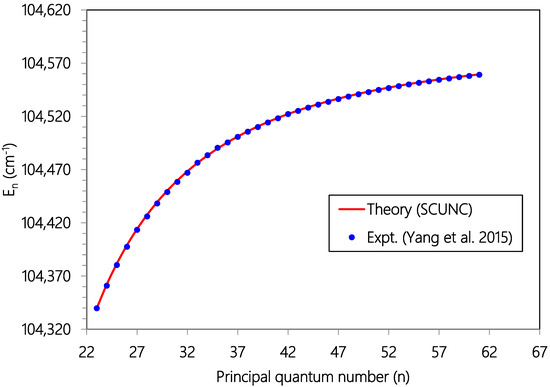
Figure 1.
Plot of Resonance energies (En, cm−1) versus principal quantum number (n) for the 3s23p4 (3P2,1)ns (4P5/2) Rydberg series of resonances originating from the Cl (2P03/2) ground state. Experimental data (solid blue circles, Ref. [18] and theoretical estimates (solid red line, SCUNC).
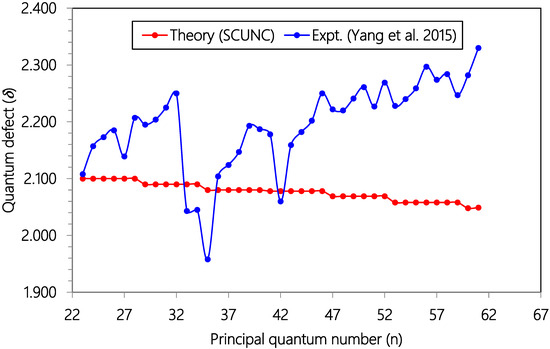
Figure 2.
Plot of quantum defects (δ) versus principal quantum number (n) for the 3s23p4 (3P2,1)ns (4P5/2) Rydberg series of resonances originating from the Cl (2P03/2) ground state. Experimental data (solid blue circles, Ref. [18]) and theoretical estimates (solid red circles, SCUNC).

Figure 3.
Plot of resonance energies (En, cm−1) versus principal quantum number (n) for the 3s23p4 (3P1)nd (2D5/2) Rydberg series of resonances originating from the Cl (2P03/2) ground state. Experimental data (solid blue circles Ref. [18] and solid green triangles Ref. [19]) and theoretical estimates (solid red line, SCUNC).
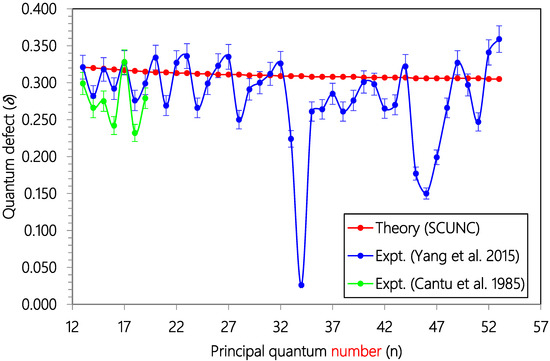
Figure 4.
Plot of quantum defects (δ) versus principal quantum number (n) for the 3s23p4 (3P1)nd (2D5/2) Rydberg series of resonances originating from the Cl (2P03/2) ground state. Experimental data (solid blue circles Ref. [18] and solid green circles Ref. [19]) and theoretical estimates (solid red circles, SCUNC).
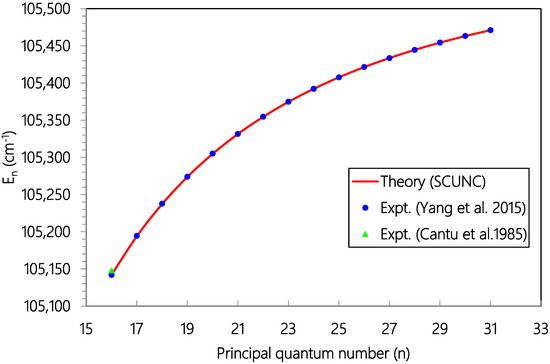
Figure 5.
Plot of resonance energies (En, cm−1) versus principal quantum number (n) for the 3s23p4 (3P0)nd (2P3/2) Rydberg series of resonances originating from the Cl (2P03/2) ground state. Experimental data (solid blue circles Ref. [18] and solid green triangles Ref. [19]) and theoretical estimates (solid red line, SCUNC).
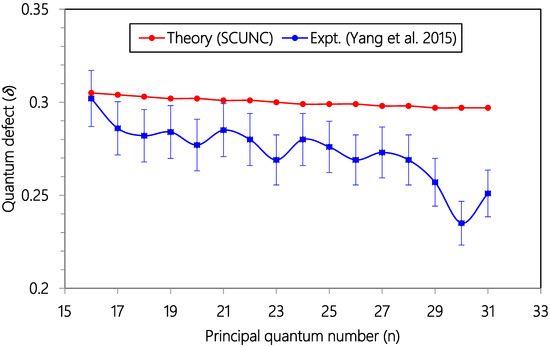
Figure 6.
Plot of quantum defects (δ) versus principal quantum number (n) for the 3s23p4 (3P0)nd (2P3/2) Rydberg series of resonances originating from the Cl (2P03/2) ground state. Experimental data (solid blue circles Ref. [18]) and theoretical estimates (solid red circles, SCUNC).
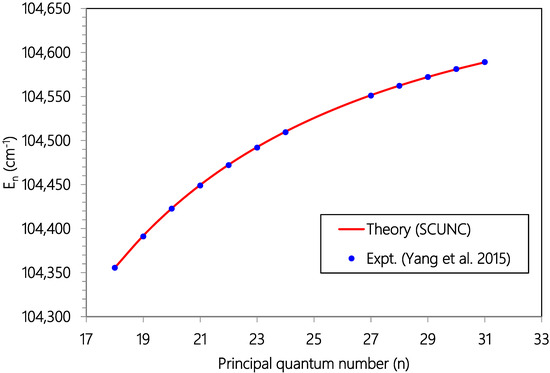
Figure 7.
Plot of resonance energies (En, cm−1) versus principal quantum number (n) for the 3s23p4 (3P0)nd (2P3/2) Rydberg series of resonances originating from the Cl (2P01/2) excited state. Experimental data (solid blue circles Ref. [18]) and theoretical estimates (solid red line, SCUNC).
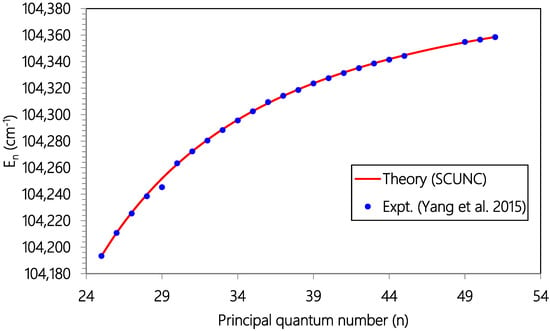
Figure 8.
Plot of resonance energies (En, cm−1) versus principal quantum number (n) for the 3s23p4 (3P1)ns (2P3/2) Rydberg series of resonances originating from the Cl (2P01/2) excited state. Experimental data (solid blue circles Ref. [18]) and theoretical estimates (solid red line, SCUNC).
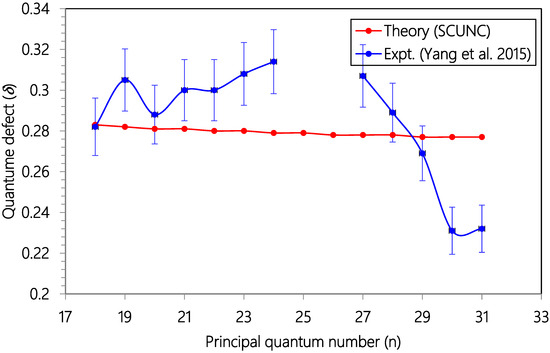
Figure 9.
Plot of quantum defects (δ) versus principal quantum number (n) for the 3s23p4 (3P0)nd (2P3/2) Rydberg series of resonances originating from the Cl (2P01/2) excited state. Experimental data (solid blue circles Ref. [18]) and theoretical estimates (solid red circles, SCUNC).

Figure 10.
Plot of quantum defects (δ) versus principal quantum number (n) for the 3s23p4 (3P1)ns (2P3/2) Rydberg series of resonances originating from the Cl (2P01/2) excited state. Experimental data (solid blue circles Ref. [18]) and theoretical estimates (solid red circles, SCUNC).
4. Summary and Conclusions
In this paper, the first calculations of resonance energies, quantum defects and effective charges of several Rydberg series resulting from the ejection of 3p electrons from the 2P03/2 ground state and 2P01/2 excited state of the neutral chlorine atom was carried out. Overall, very good agreements were obtained between the present SCUNC calculations and the available experimental data for resonance energies. In addition, for all the resonance energies associated with an experimental quantum defect that varied in all directions, an almost constant SCUNC quantum defect was tabulated up to n = 70. The new SCUNC data quoted in the listed tables may be of great interest for the physical community focusing their studies on the photoionization of atomic chlorine.
Author Contributions
M.T.G.: Conceptualization, Methodology, Investigation, Formal analysis, Writing—original draft, Writing—review and editing. I.S.: Methodology, Investigation, Writing—review and editing, Visualization, Formal analysis, Supervision. All authors have read and agreed to the published version of the manuscript.
Funding
This research received no funding.
Data Availability Statement
Data is contained within this article.
Conflicts of Interest
The authors declare that they have no known competing financial interest or personal relationship that could have appeared to influence the work reported in this paper.
References
- McLaughlinand, B.M.; Balance, C.P. Photoionization Cross-Sections for the trans-iron element Se+ from 18 eV to 31 eV. J. Phys. B At. Mol. Opt. Phys. 2012, 45, 095202. Available online: https://iopscience.iop.org/article/10.1088/0953-4075/45/9/095202 (accessed on 11 September 2023). [CrossRef]
- Bizau, J.M.; Champeaux, J.P.; Cubaynes, D.; Wuilleumier, F.J.; Folkmann, F.; Jacobsen, T.S.; Penent, F.; Blancard, C.; Kjeldsen, H. Absolute cross sections for L-shell photoionization of the ions N2+, N3+, O3+, O4+, F3+, F4+ and Ne4+. Astron. Astrophys. 2005, 439, 387–399. [Google Scholar] [CrossRef]
- Nahar, S.N. Photoionization features of the ground and excited levels of Cl II and benchmarking with experiment. New Astron. 2021, 82, 101447. [Google Scholar] [CrossRef]
- Dufour, R.J. The unique planetary nebula NGC 2818. Astrophys. J. 1984, 287, 341–352. Available online: https://adsabs.harvard.edu/full/1984ApJ...287..341D (accessed on 11 September 2023). [CrossRef]
- Fegley, B.; Zolotov, M.Y. Chemistry of Sodium, Potassium, and Chlorine in Volcanic Gases on Io. Icarus 2000, 148, 193–210. [Google Scholar] [CrossRef]
- Moomey, D.; Federman, S.R.; Sheffer, Y. Revisiting the chlorine abundance in diffuse interstellar clouds from measurements with the copernicus satellite. Astrophys. J. 2012, 744, 174. Available online: https://iopscience.iop.org/article/10.1088/0004-637X/744/2/174/meta (accessed on 11 September 2023). [CrossRef]
- Robicheaux, F.; Green, C.H. Partial and differential photoionization cross sections of Cl and Br. Phys. Rev. A 1993, 47, 1066. Available online: https://www.physics.purdue.edu/~robichf/papers/pra47_1066.pdf (accessed on 11 September 2023). [CrossRef]
- Lamoureux, M.; Farnoux, F.C. Photoionization cross section of the open 3p subshell in atomic chlorine. J. Phys. 1979, 40, 545. [Google Scholar] [CrossRef]
- James, A.R.; Samson; Shefer, Y.; Angel, G.C. A Critical Test of Many-Body Theory: The Photoionization Cross Section of Cl as an Example of an Open-Shell Atom. Phys. Rev. Lett. 2020, 56, 2020. [Google Scholar] [CrossRef]
- Schectman, R.M.; Federman, S.R.; Brun, M.; Cheng, S.; Fritts, M.C.; Irving, R.E.; Gibson, N.D. Oscillator Strengths for Ultraviolet Resonances in Cl II and Cl III. Astrophys. J. 2005, 621, 1159–1162. Available online: https://iopscience.iop.org/article/10.1086/427918/meta (accessed on 11 September 2023). [CrossRef]
- Hernández, E.; Juárez, A.; Kilcoyne, A.; Aguilar, A.; Hernández, L.; Antillón, A.; Macaluso, D.; Morales-Mori, A.; González-Magaña, O.; Hanstorp, D.; et al. Absolute measurements of chlorine Cl+ cation single photoionization cross section. J. Quant. Spectosc. Radiat. Transf. 2015, 151, 217–223. [Google Scholar] [CrossRef]
- Nahar, S.N.; Hernández, E.M.; Kilkoyne, D.; Antillón, A.; Covington, A.M.; González-Magaña, O.; Hernández, L.; Davis, V.; Calabrese, D.; Morales-Mori, A.; et al. Experimental and Theoretical Study of Photoionization of Cl III. Atoms 2023, 11, 28. [Google Scholar] [CrossRef]
- Mosnier, J.P.; Kennedy, E.T.; Bizau, J.M.; Cubaynes, D.; Guilbaud, S.; Blancard, C.; Hasoğlu, M.F.; Gorczyca, T.W. L-Shell Photoionization of Magnesium-like Ions with New Results for Cl5+. Atoms 2023, 11, 66. [Google Scholar] [CrossRef]
- McLaughlin, B.M. Photoionization of Cl+ from the 3s23p4 3P2,1,0 and the 3s23p4 1D2,1S0 states in the energy range 19–28 eV. Mon. Not. R. Astron. Soc. 2017, 464, 1990–1999. [Google Scholar] [CrossRef]
- Kim, D.S.; Kwon, D.H. Theoretical photoionization spectra for Mg-isoelectronic Cl5+ and Ar6+ ions. J. Phys. B At. Mol. Opt. Phys. 2015, 48, 105004. Available online: https://iopscience.iop.org/article/10.1088/0953-4075/48/10/105004/meta (accessed on 11 September 2023). [CrossRef]
- Ba, M.D.; Diallo, A.; Badiane, J.K.; Gning, M.T.; Sow, M.; Sakho, I. Photoionization of the 3s23p3nd Rydberg series of Cl+ ion using the Screening constant by unit nuclear charge method. Radiat. Phys. Chem. 2018, 153, 111–119. [Google Scholar] [CrossRef]
- Nahar, S.N. Characteristic features in photoionization of Cl III. In Proceedings of the 54th Annual Meeting of The Aps Division of Atomic, Molecular And Optical Physics, Spokane, WA, USA, 5–9 June 2023; Available online: https://meetings.aps.org/Meeting/DAMOP23/Session/C11.1 (accessed on 11 September 2023).
- Yang, L.; Gao, H.; Zhou, J.; Ng, C.Y. Vacuum ultraviolet laser photoion and pulsed field ionization–photoion study of Rydberg series of chlorine atoms prepared in the (j = 3/2 and 1/2) fine-structure states. Astrophys. J. 2015, 810, 132. Available online: https://iopscience.iop.org/article/10.1088/0004-637X/810/2/132 (accessed on 11 September 2023). [CrossRef]
- Cantu, A.M.; Parkinson, W.H.; Grisendi, T.; Tagliaferri, G. Absorption Spectrum of Atomic Chlorine: 3p5 2P3/2,1/20 3p4 ns,nd. Phys. Scr. 1985, 31, 579. Available online: https://iopscience.iop.org/article/10.1088/0031-8949/31/6/019 (accessed on 11 September 2023). [CrossRef]
- Sakho, I. The Screening Constant by Unit Nuclear Charge Method. In Description & Application to the Photoionization of Atomic Systems; ISTE Science Publishing Ltd.: London, UK; John Wiley & Sons, Inc.: New York, NY, USA, 2018. [Google Scholar]
- Gning, M.T.; Sakho, I. Single Photoionization Study of Br3+ via the Screening Constant by Unit Nuclear Charge Method. J. At. Mol. Condens. Nano Phys. 2019, 6, 131–141. [Google Scholar] [CrossRef]
Disclaimer/Publisher’s Note: The statements, opinions and data contained in all publications are solely those of the individual author(s) and contributor(s) and not of MDPI and/or the editor(s). MDPI and/or the editor(s) disclaim responsibility for any injury to people or property resulting from any ideas, methods, instructions or products referred to in the content. |
© 2023 by the authors. Licensee MDPI, Basel, Switzerland. This article is an open access article distributed under the terms and conditions of the Creative Commons Attribution (CC BY) license (https://creativecommons.org/licenses/by/4.0/).